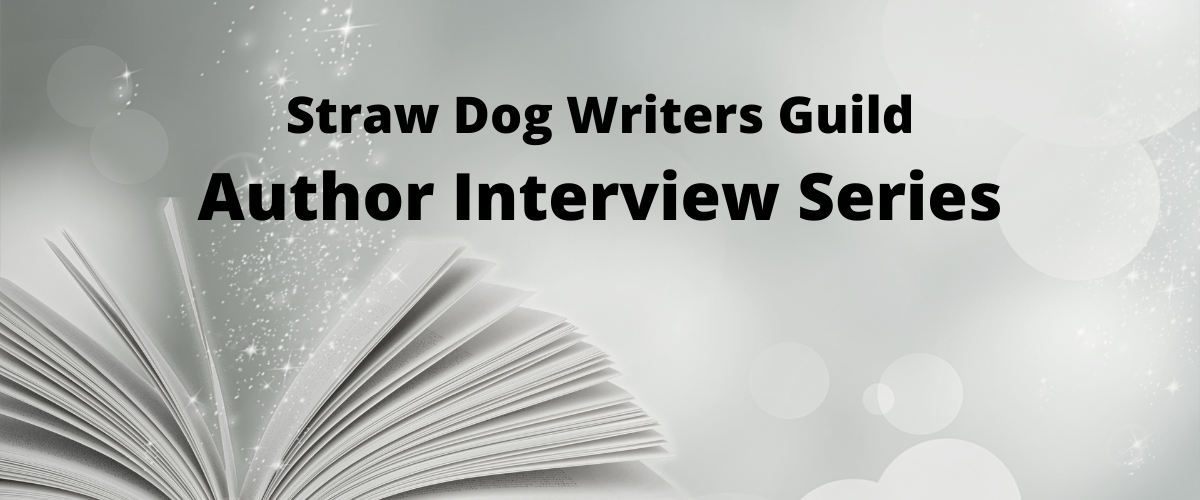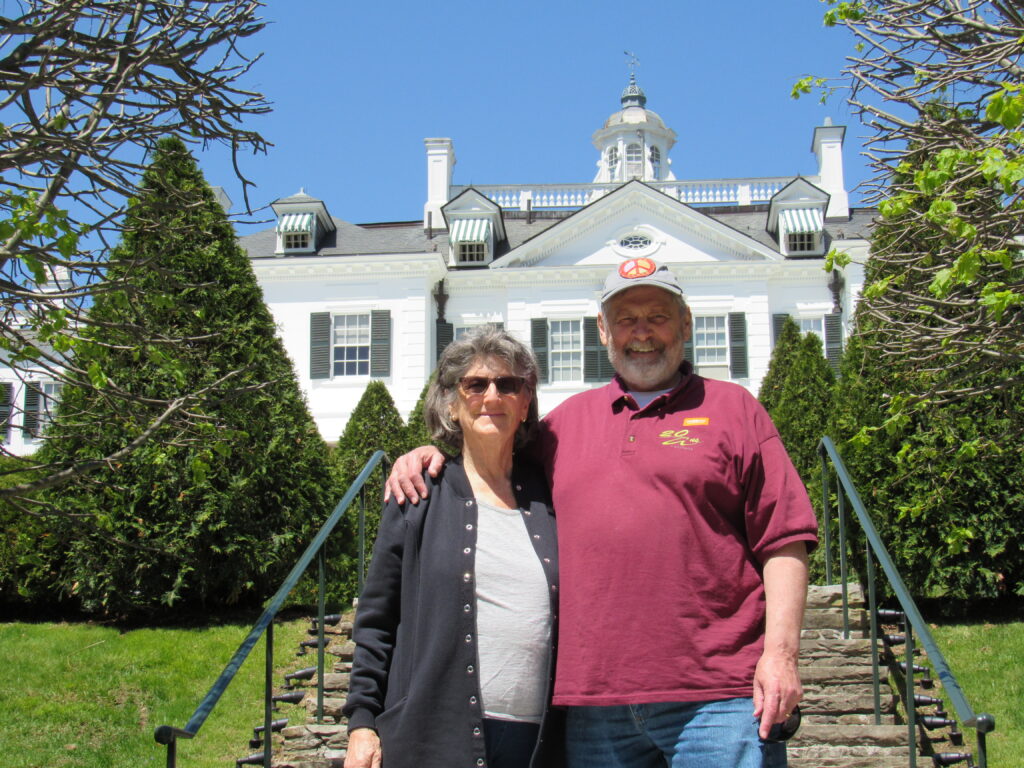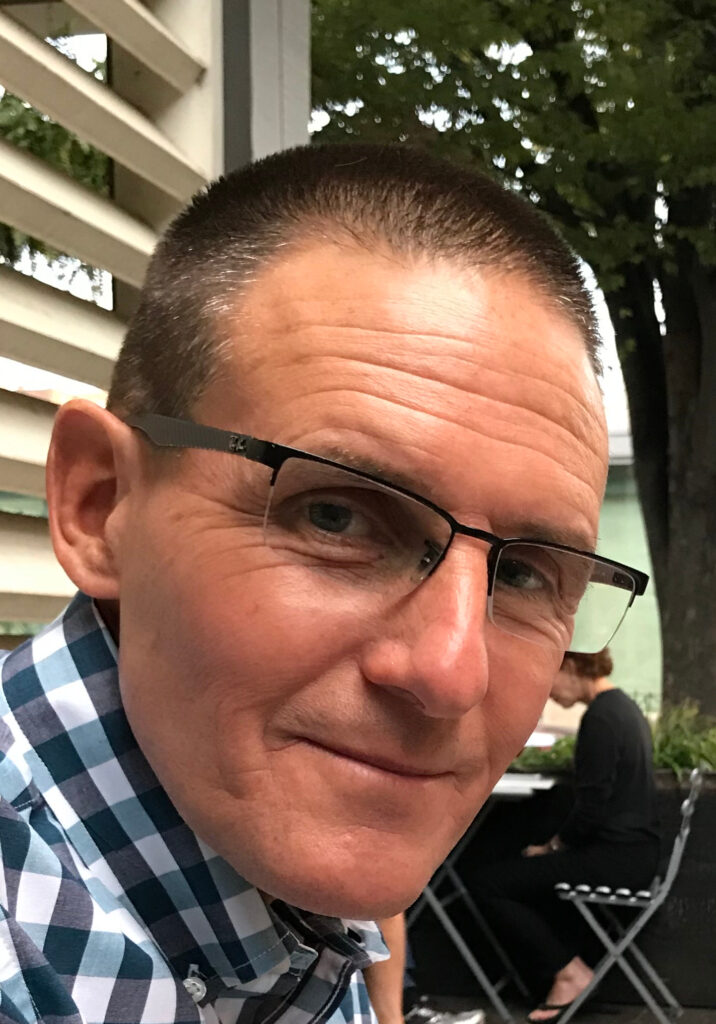Bela Breslau and Stephen Billias are the co authors of the forthcoming novel Pilgrim Maya, which they plan to release next summer. Stephen’s most recent book is A Book of Fields: Tales from the Pioneer Valley, a short story collection which they published in 2019. Stephen has also written seven novels of science fiction and fantasy, including The American Book of the Dead, and The Quest for the 36. He recently retired from a long business career as a project manager and technical writer. Bela is writing a family history focusing on her father, a farmer and immigrant from Russia who was known for his good deeds. The couple have long been practitioners and teachers of Shintaido, a Japanese body movement and martial art. In 2006 they created The Shintaido Farm, where they lived, taught, and studied Shintaido for 10 years. Since 2016, they have lived in the town of Deerfield, and while they continue to practice and teach Shintaido, they are now focusing on their writing.
SDWG: Before we discuss your writing projects specifically, I’d really like to know more about your collaborative writing process. How do you operate? How do you divide or share the many smaller jobs inherent in the creation of something as complex and (perhaps) as personal or individual as a novel? Do you have defined roles in the process or are there times when you “trade hats” so to speak?
Bela: Stephen came up with the initial concept and story line. He invited me to co-write the book because the main character is a woman and he wanted insights into the feminine psyche. Stephen has always written “a page a day” on his many writing projects. He would send me an electronic file. I would make edits and pass the file back to him. It became a seamless process, each of us adding new pages.
Stephen: I had to change my writing process to work with Bela. She needed a full outline of the book and studies of the characters before starting to write the novel. This was a new process for me, and it added to the richness of working together and improved the final result.
SDWG: The shift to writing collaboratively has come pretty recently in your careers. How has writing together changed your writing separately? Has working on the same project changed how or what you write individually?
Stephen: Yes, I found that I wrote an outline and character studies for a book I wrote after writing Pilgrim Maya.
Bela: I’m trying to stick to Stephen’s page a day method on my own project. With difficulty. I definitely need his project management to move me along.
SDWG: I’m also really interested in the role that your Shintaido practice plays in your writing process, i.e. when and how you employ it (or don’t). An Old Question arises from this of course: are meditative presence and imagination somewhat simultaneous or rather sequential frames of mind? One of my favorite poets, Gary Snyder, has long used his Buddhism as a wellspring for his art. How does it work for each of you?
Bela: Our collaboration was an extension of our co-teaching of Shintaido. We had taught together at the Shintaido Farm, now the Engaged Mindfulness Institute, and at workshops in the United States and Canada. Shintaido and our more recent explorations in meditation were foundational and made the story come alive.
SDWG: Stephen, you also do a lot of technical writing professionally. How do the skills involved in technical writing contrast or coincide with your craft as a writer of fiction?
Stephen: I keep the two worlds separate, though I use editing skills in both settings. Some writers might find more overlap but I’ve managed to compartmentalize the two forms of writing. For many years I have had a pretty disciplined routine of writing creatively in the morning before starting business work. That way I always feel I’ve accomplished the thing most important to me first. Everything else is secondary and just to make money to support my avocation.
SDWG: A Book of Fields is a collection of short stories about the people of the Pioneer Valley – certainly fertile ground for fiction – and elements of the supernatural and magic make their presence felt in some of the stories. Can you tell us a little about how the landscape and the character of the region has inspired you, maybe with some examples from the book?
Stephen: from the back cover of the book: “The junkie son of a railroad man tries to rob a train. Three local kids hold up Wade’s Diner and get caught. A shady antiques dealer is outwitted by a customer. There’s a ghost in the Quabbin Reservoir. A history teacher at a local private school decides to restage the great Deerfield Raid of 1704 using his students and some local Native Americans, with disastrous results. Some of the stories contain a crime, or something like one, but this is not a crime novel. It’s a deceptively simple book inspired by the people of the Pioneer Valley – hardy, independent, passionate, sometimes hard-headed and a little crazy!”
SDWG: Bela, you’ve been working on the cross-genre book about your father for quite a while. Can you tell us a little about the project and your vision for it?
Bela: For my father, Sam, helping people was a natural part of who he was. It came easily to him. Around the time of his 85th birthday, I decided to interview him and ask questions about his life and philosophy. One of Stephen’s first published novels, The Quest for the Thirty-Six was based on the mystical tradition in Jewish folklore that there are thirty-six righteous men and women, Lamed-Vovniks, who keep the world in balance. I started to blend the story of my father helping people with the larger legend and the history surrounding Jews coming to America. It is a work in progress.
SDWG: Pilgrim Maya follows the title character on a journey to find a spiritual home. How does her story share elements of a classic quest narrative in which the protagonist goes on a journey to find enlightenment? Are there ways in which her journey departs from this traditional pattern?
Stephen: Yes, it’s a classic quest in three parts. Maya goes down a couple of false paths before finding redemption in “socially engaged Buddhism.”
SDWG: In our earlier conversation, you said that you used some of the people and situations that you encountered as students and teachers of Shintado as inspiration and models for Maya’s story. Can you share some examples?
Bela: When it came to establishing characters and coming up with personality traits, I would often suggest descriptions based on people who were teachers or students we had known over the years. But I think it’s more fun for people to have to guess at who might be models for characters than to say so in print!
SDWG: As I understand it, Maya’s story takes place in the 60s, a time when many people were searching for more balanced, fulfilling lives. Obviously our current moment shares both parallels and contrasts with that era. I wonder if you could describe how the specific settings of the novel relate to our here and now?
Bela: The setting for the novel is not tied to a particular year, but it is based on our experiences in the San Francisco Bay area. We both lived there from the late 1970s until we left in 2004. We were both searching for meaning and also being part of a community that supported and sustained us.
Stephen: We’re both children of the 60s, a time of great change. Our current era shares some of those characteristics. Without being too specific, the book is set in the pre-pandemic era so there’s nothing of the turmoil and suffering of the recent past, but suffering is a universal human experience and Maya’s search for healing is timeless.
SDWG: Between the two of you, your writing has touched many genres; everything from science fiction and fantasy, to personal and family history, to short fiction, and now a novel. With that broad scope in mind, who do each of you look to as models for your writing?
Bela: This is a hard question. Makes me think of those New York Times Book Review questions: “What books are by your bedside?” “Who are your influences?” “What three writers would you invite to dinner?” I like stories. Fiction. I sometimes dream of rewriting famous books and making them come out differently. Anna Karenina, grabbing great sacks of valuables and jewels, her son, and running off to lead a rich life in Paris. Or the characters in Edith Wharton’s, The Age of Innocence, just running off together.
Stephen: Though I was published in the science fiction genre previously, I don’t consider myself a sci-fi writer. I thought I was writing magical realism, more like Borges or Marquez than sci-fi or fantasy. But fantasy is easier to sell than serious literature, and that’s where the books got published. Like Bela, I like stories. I’ve just returned from a trip to Poland where I made a pilgrimage to the childhood street of Isaac Bashevis Singer, one of my literary favorites. Singer populated his Polish world with imps, demons, and dybbuks, and he won the Nobel Prize for literature!
SDWG: In your work and life together, is there a literary partnership from the past that you see as an inspiration? There have been lots of famous ones of course, many happy, and many, well…not so much. Are there tactics that you use to keep things positive and moving forward?
Bela: Other couples, some who are writers and creative people, have often stated that they would never be able to write together. We developed an exciting collaboration that informed the book and also enriched our marriage. We were some of the lucky ones.
Stephen: I like to think of us as like Percy and Mary Shelley, each inspiring the other to greater imaginative literary creations. But I majored in 19th-century English literature!
SDWG: Pilgrim Maya is set to be released next summer. What’s next? Is there another novel in the works? Do you have any readings or appearances planned?
Stephen: Yes, we have a sequel planned for Pilgrim Maya, in which our main character Maya comes east and founds a Buddhist retreat center with her new partner Peter, a character from the first book. It’s not too hard to see how The Center at Pilgrim Farm will draw from our experiences as founders and managers of the Shintaido Farm, the place we built for the practice of the esoteric Japanese body movement and martial art Shintaido. We also rented the Farm to many interesting groups, from T’ai Chi and Yoga to dance groups and other meditation practices. The Center at Pilgrim Farm makes use of those experiences to further Maya’s spiritual journey.
Bela: Next year is our 30th wedding anniversary. We had planned a trip around the United States to celebrate, and now we’re turning it into a book tour, lining up readings and signings in bookstores in major cities where we have friends who can help us bring people into the bookstores. It should be a fun and exciting time. Senior road trip!
Access and Contact
Bela and Stephen’s website: https://billiasbreslauwriters.com/
*********************************************************
Interviewer: Mark Luebbers, Straw Dog Writers Guild member
Mark Luebbers is a teacher and writer living in Greenfield, Massachusetts. His work focuses on nature and the environment, the lives of eccentric and creative figures from history, and living in America. Mark has published poems in a number of journals and magazines in recent years, including The American Journal of Poetry, The Journal of Americana, Wayfarer Magazine, Apple Valley Review, Blue Line, and The Hopper. In 2018, Mark was nominated for two Pushcart Prizes. “Flat Light”, his first collection, was published in 2020 by Urban Farmhouse Press. “Citizens of Ordinary Time”, a collection of biographical and ekphrastic poems written in collaboration with Ben Goluboff, is forthcoming, also from UFP.



